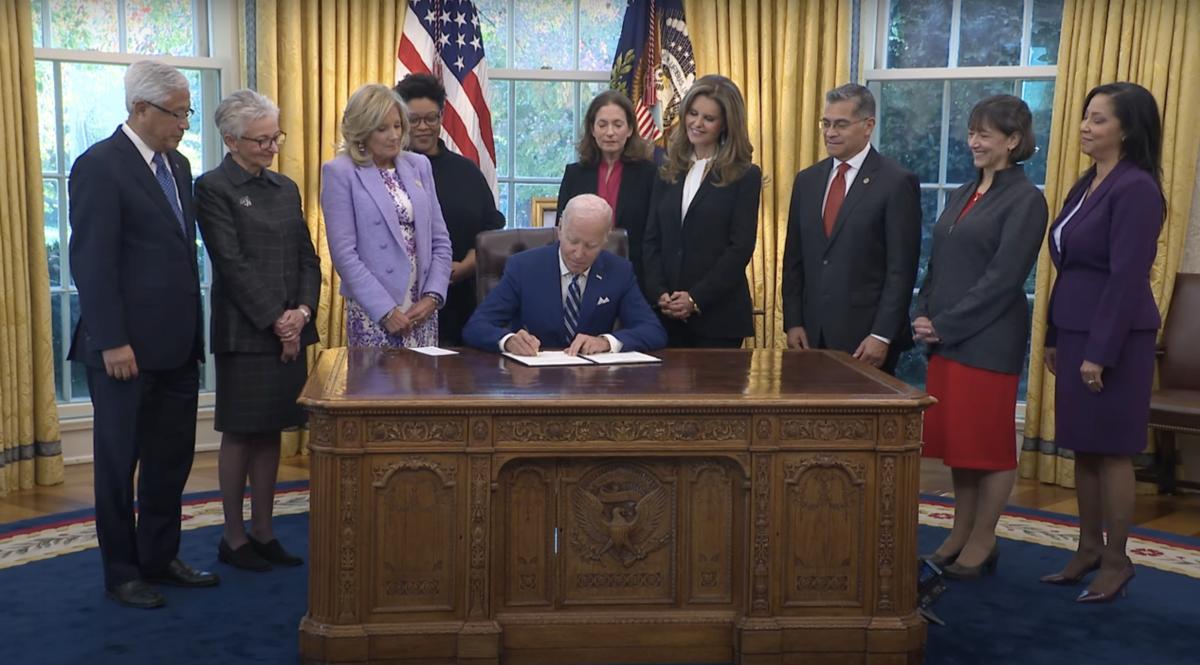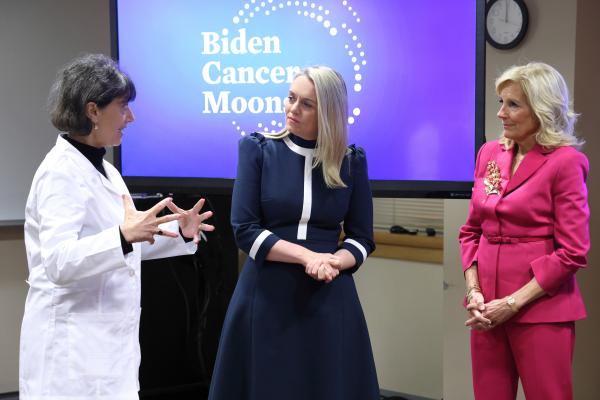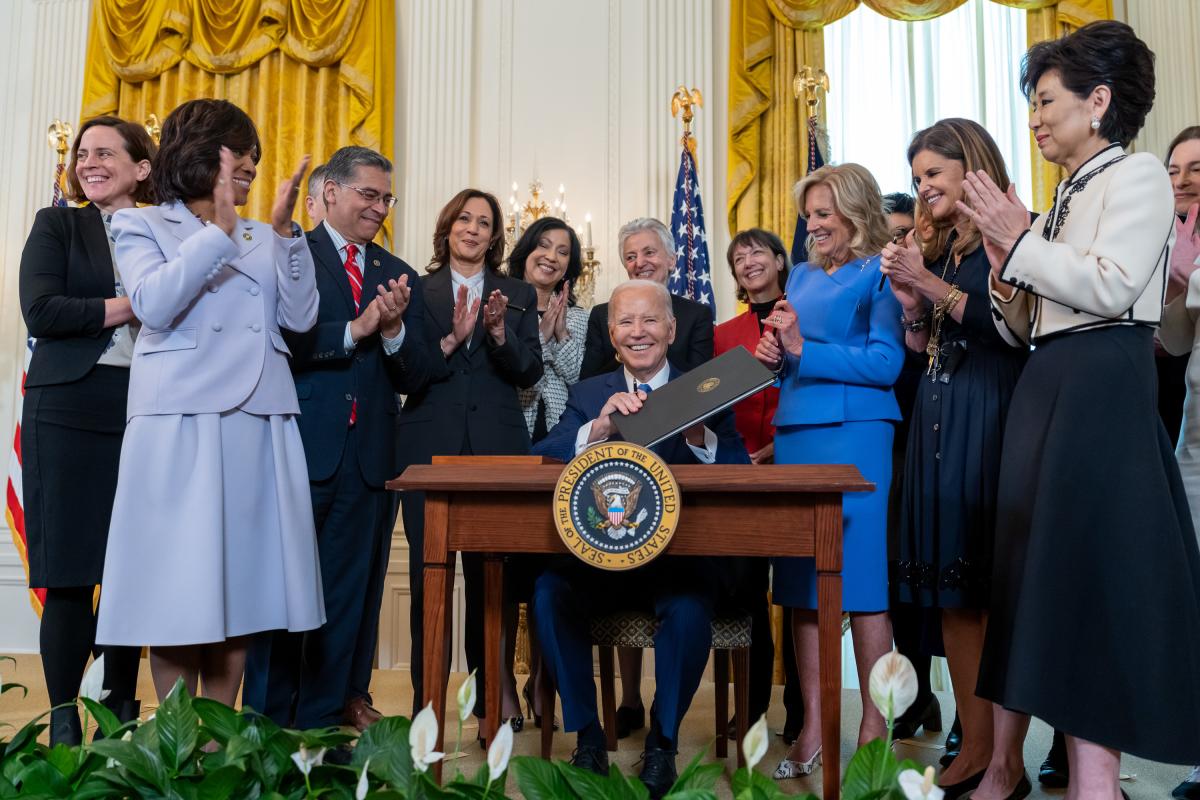President Biden Requests $12B for Research on Women’s Health
NIH Is Poised to Perform
BY JENNIFER HARKER, THE NIH CATALYST

CREDIT: WHITE HOUSE
President Biden signed a Presidential Memorandum to establish the White House Initiative on Women’s Health Research.
President Biden signed the most comprehensive set of executive actions ever taken to advance women’s health research on March 18. His Executive Order, and a State of the Union request to Congress for a “bold, transformative investment” of $12 billion, comes on the heels of a November Presidential Memorandum that charged every federal agency engaged in health research to develop a plan for advancing women’s health research.
“I have always believed in the power of research to save lives and to ensure that Americans get the high-quality health care they need. To achieve scientific breakthroughs and strengthen our ability to prevent, detect, and treat diseases, we have to be bold. That’s why today, we’re establishing a new White House Initiative on Women’s Health Research so that my Administration—from the National Institutes of Health to the Department of Defense—does everything we can to drive innovation in women’s health and close research gaps,” said President Biden in the official White House fact sheet on the Presidential Memorandum.
“Never before has there been such a comprehensive effort from the federal government to spur innovation in women’s health research,” said Carolyn Mazure, who chairs the initiative. “This is a huge opportunity for transformative change that can improve the health and the lives of women across this country.” Mazure is the Norma Weinberg Spungen and Joan Lebson Bildner professor in women’s health research and professor of psychiatry and psychology at Yale School of Medicine (New Haven, Connecticut). She is taking leave from her duties at Yale to work alongside First Lady Jill Biden, in collaboration with the White House Gender Policy Council, to establish and advance this new White House Initiative on Women’s Health Research.

CREDIT: ROBERT LISAK
Carolyn Mazure
NIH is well prepared
NIH is, of course, at the forefront of this charge. An agency-wide effort will be launched to close gaps in women’s health research across the lifespan. The NIH has committed $200 million in the FY25 NIH budget to support this work and President Biden’s budget request includes funding to double the current budget for the NIH Office of Research on Women’s Health (ORWH), which is led by Janine Austin Clayton.
Expounding on the five key areas of this executive order, NIH will embark on a biomarker discovery effort, begin its first ever Pathways to Prevention Series on menopause and the treatment of menopausal symptoms, and engage in an effort to identify and develop new common data elements that are specifically related to women’s health. Moreover, menopause has just been added as a research category to the NIH Research, Condition, and Disease Categorization.
“The Biden women’s health initiative will galvanize our intramural investigators around efforts to understand, treat, and prevent disorders that disproportionately affect women and to recognize the unique clinical presentations of disorders common to people of both sexes,” said Nina Schor, deputy director for intramural research. “Every NIH institute has a role to play in this initiative because of their already robust efforts focused on such disorders as autoimmune conditions, migraine, multiple sclerosis, preeclampsia, and postpartum depression, which are more frequently seen in women than in men, and on the unique ways in which heart injury and lung dysfunction, for example, present in women.”
A central fund for women’s health research at the NIH to advance interdisciplinary science also is being requested, according to Mazure. In addition, this White House Initiative hopes to fund the creation of a new nationwide network of research centers of excellence and innovation.
“We know that healthy women contribute to healthy families, healthy communities, healthy cities, healthy economies, and so much more, and that benefits everyone. NIH is excited and prepared to help leverage the recent executive order to accelerate research that will provide much needed answers and tools to help prevent, diagnose, and treat conditions that affect women uniquely, disproportionately, and differently,” said Tara Schwetz, deputy director of Program Coordination, Planning, and Strategic Initiatives, at the 60th meeting of the NIH Advisory Committee on Research on Women’s Health (ACRWH), April 9.
At that meeting, experts in women’s health research gathered to discuss the new initiative, as well as disturbing trends in the reduced life expectancy of Americans, and especially women. As NIH Director Monica Bertagnolli pointed out during her talk, “Among our main guiding principles at NIH, the very first one is that our work is not finished when we deliver scientific discoveries. Our work is finished when all people are living long and healthy lives.”

CREDIT: CHIACHI CHARLIE CHANG
Pictured left to right is NIH Director Monica Bertagnolli, Jodie Haydon of Australia, and First Lady Jill Biden during a visit to the NIH Clinical Center in October 2023.
Making inroads
Mazure accompanied the First Lady at numerous listening sessions across the country after the initial November Presidential Memorandum to hear from a wide range of stakeholders about the health concerns of women. Together, they toured laboratories and held community listening sessions where they heard from patients, health care providers, researchers, advocacy groups, and others in the public and private sectors. Among the prominent themes that arose was the need to translate critical research findings into the marketplace in a timelier manner.
Progress is already being made.
- The Advanced Research Projects Agency for Health, or ARPA-H, Sprint for Women’s Health $100 million funding initiative, which just launched in March, will accelerate discoveries from early-stage proof of concept to products ready to be commercialized, according to Mazure. “Although technologies capable of diagnosing and possibly treating diseases across all ages and stages of a woman’s life are increasingly possible, very few are affordable and are currently available in the marketplace or are easy to use,” she noted.
- Moreover, last August, the NIH’s Implementing a Maternal health and PRegnancy Outcomes Vision for Everyone (IMPROVE) Initiative established 10 maternal health research centers of excellence across the country. Bertagnolli said these institutions are working together to design and implement research studies that address the biological, behavioral, environmental, sociocultural, and structural factors that can lead to or help prevent pregnancy-related complications and death.
“To fully realize this opportunity, we need to work together across sectors and industries to ensure that all of U.S. government, research centers, advocacy organizations, philanthropy, and the private sector are doing everything we can to close research gaps in women’s health. Thanks to First Lady Dr. Jill Biden’s leadership, this initiative will continue taking action to advance women’s health research so that women get the answers they need when it comes to their health,” Mazure said in her closing remarks.

CREDIT: WHITE HOUSE
NIHers at the signing of the President Biden’s Executive Order in March included NIH Director Monica Bertagnolli; Tara Schwetz, deputy director for Program Coordination, Planning, and Strategic Initiatives; Janine Austin Clayton, ORWH director; and Vivian Ota Wang, ORWH deputy director.
Sex differences matter
A concept clearance for sex differences in autoimmune disease also was presented at the April 9 ACRWH meeting. One year ago, ORWH established the NIH Office of Autoimmune Disease Research. Mazure noted that 80% of those with autoimmune disorders in the United States are women. Women have a greater likelihood of developing chronic conditions as well as multiple disorders that occur at the same time.
“Conditions affect women differently than men, such as those found in heart disease and in most brain-based disorders,” Mazure explained. “Whether it’s smoking or epilepsy or multiple sclerosis; wherever we look, we find that sex differences matter.”
Join the ORWH May 12–15 for National Women’s Health Week
- NIH fact sheets on Women’s Health Research
- NIH-wide strategic plan for Research on the Health of Women, 2024–2028
- U3 interdisciplinary research: Bringing women of understudied, underrepresented, and underreported populations databook into focus
- Future directions in menopause research: Optimizing midlife health of women
- 8th annual Vivian W. Pinn Symposium, May 15
Learn more at https://orwh.od.nih.gov/our-work/events
President Biden signs executive order to advance women’s health research
This page was last updated on Tuesday, December 3, 2024
